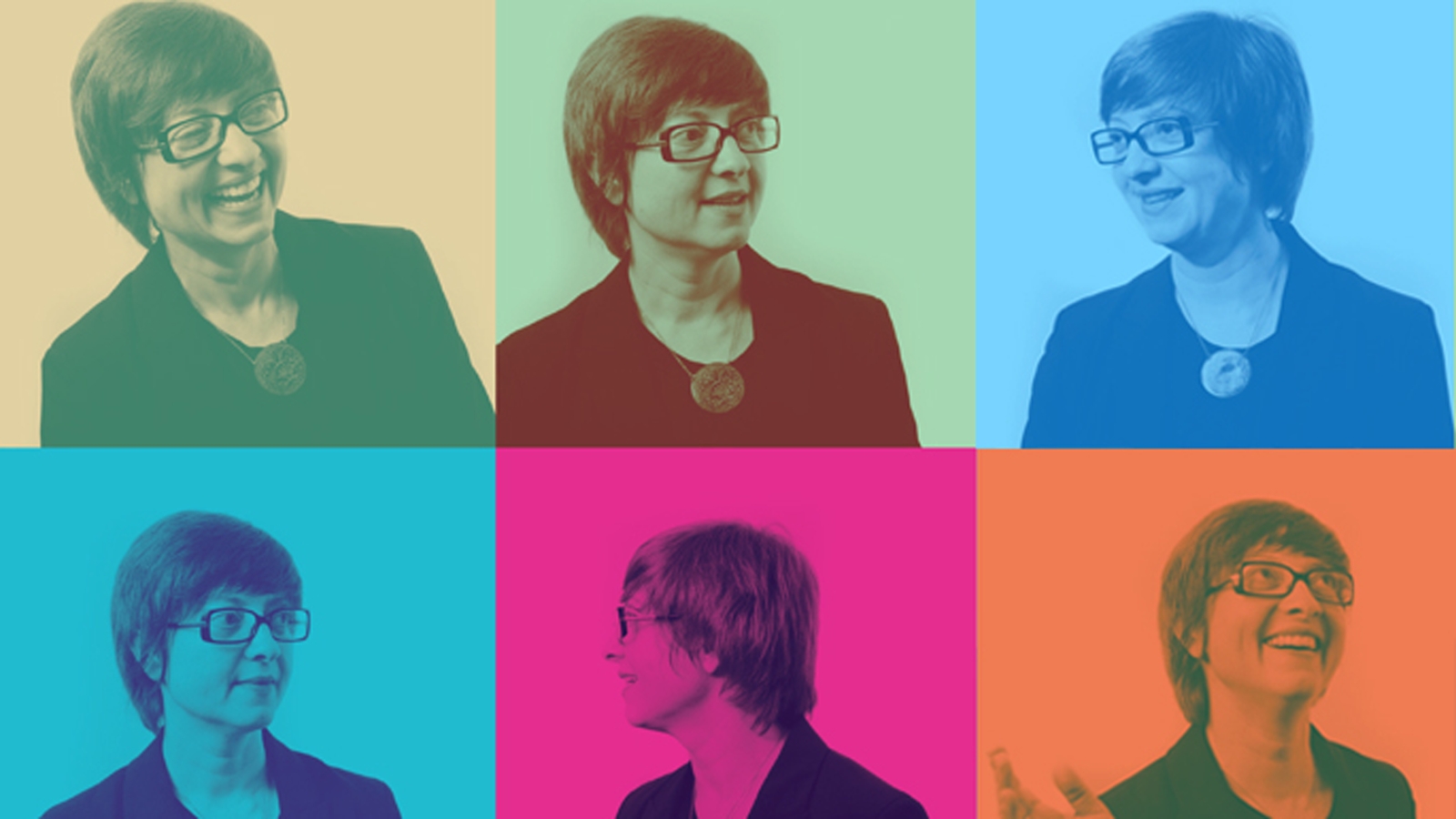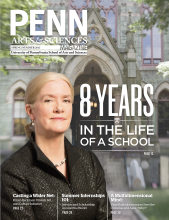Chances are, even as you read this, that there’s a cultural event taking place on or around the Penn campus that you don’t know about. On any given day there are Egyptian mummies at Penn Museum, a Pulitzer-Prize winning author at Kelly Writers House, or a cutting-edge exhibit at the Institute of Contemporary Art (ICA), yet when people think of the arts, they don’t always think of Penn.
Karen Beckman wants to change that.
The Elliot and Roslyn Jaffe Endowed Professor in Film Studies is taking on the challenge of making sure Penn is on the culture map through a comprehensive new Art and Culture Initiative. In addition to increasing accessibility to the arts at Penn, the initiative seeks to improve communication among faculty, students, and art and culture centers on campus, as well as between the campus, general public, and outside art and culture organizations. This includes finding new ways to attract top art and culture applicants, equipping existing students with new resources, and introducing new art and culture courses and internships. “The richness of the arts at and around Penn sometimes goes under the radar,” says Beckman, one of the world’s preeminent film scholars. “There are so many exciting activities that don’t get recognized. Most students don’t even realize, for instance, that Andy Warhol had his first solo show at ICA. Penn arts has an exciting history, and we need to guarantee that legacy is maintained.”
Beckman’s first major undertaking was bringing together representatives from local arts organizations, both on and off campus. In addition to internationally recognized mainstays like Penn Museum and ICA, she recruited directors from Kelly Writers House, WXPN, the Penn Libraries and Special Collections, the Annenberg Center, the Arthur Ross Gallery, and the Morris Arboretum. “We face a competitive challenge, and communication is the key,” she notes. “Many of our peers are developing expensive arts centers on campus in order to attract top students. But I don’t think the top-down, agenda-driven approach is right for Penn. We embrace independent thinkers and decentralization here. So the goal of the committee is to collaborate, not to homogenize.”
For Beckman, nurturing an already-strong relationship between Penn and West Philadelphia means keeping an open line with ambassadors from the city’s most prominent venues. These meetings have already resulted in better opportunities for students to explore the local arts scene. Penn’s shuttle bus, for instance, now includes a stop at the Philadelphia Museum of Art on nights when admission is cheaper. Also being stressed is the importance of establishing relationships with smaller arts organizations throughout the city. One example is the 30-year-old local media literacy education center, Scribe Video Center. The center, which Beckman describes as a sort of Kelly Writers House for media, makes media literacy affordable for the local community, including artists and young people, and represents a perfect example of a community organization Penn can both help and benefit from.
“You take a place like Scribe,” Beckman says. “On paper, its only relationship to Penn is in real estate holdings, but in reality it is so much more. Scribe has co-hosted lecturers with us and continues to be a resource for our students. The Center always needs skilled people to help edit and instruct community members who come to that space to learn how to use media, which translates into internships for Penn students. Their executive director, Louis Massiah, a MacArthur fellow, has often taught classes at Penn about community media and documentary. It’s this kind of symbiosis we are working toward.”
"It's all about creating avenues that put a new face on a certain aspect of the arts that students might never have experienced before." – Karen Beckman
In addition to exciting collaborations, the initiative also introduces new arts courses. This begins with pilot experiments that Beckman hopes will lead to the foundation of an arts scholars program she describes as being similar to the Benjamin Franklin Scholars Program, but with a particular focus on helping new Penn students explore art and culture in an array of formats. This goal is embodied in a series of freshman seminars that will kick off in the fall of 2013. The classes will strive to interact with greater University initiatives in meaningful ways. In a nod to Penn’s 2013-2014 annual theme, “Year of Sound,” Professor of Music Carol Muller is teaching a course on African diaspora music and Associate Professor of Music Emily Dolan is teaching Sound Art. “The courses run the gamut; Susan Bee at Kelly Writers House is teaching a course called Writing About Art that will take students around different gallery spaces and have them write a response,” says Beckman. “It’s all about creating avenues that put a new face on a certain aspect of the arts that students might never have experienced before.” Ideally, the Arts Scholars program would provide a fully-funded internship to all Penn arts students. Two exciting global internships have already been secured: one at the Museum of Modern Art in Frankfurt am Main, Germany, where a student will work with a curator on an exhibition about the Brazilian artist Helio Oiticica; and the other at the Pera Museum in Instanbul, Turkey.
Also part of the initiative is a new online arts and culture magazine that will feature student content. Brooke Sietinsons, Senior Designer of Publications and the web project lead for the initiative, also worked closely with Beckman to launch an alternative campus tour focused on appealing directly to prospective arts students. As part of this same effort to increase resources for students and visitors interested in the arts, Beckman is collaborating with Campus Philly—a nonprofit organization that encourages students to explore, live, and work in the Greater Philadelphia area—to include Penn in Open Arts, a pilot program which provides discounted arts opportunities to incoming students. If successful, and the costs of participating can be sustained over the long term, she hopes to eventually extend the passports to all incoming freshmen.
It’s a lot of coordination between a lot of parties and Beckman is the first to admit her role within the University has seen a seismic shift since her work on the initiative began. “It’s a challenge. I try to block off days and say, ‘OK, this is going to get finished no matter what!’” she laughs. Her scholarship, however, isn’t taking a back seat. She is currently at work on a new book focused on one of her passions: animation. This past fall, she hosted a conference on animation at ICA—the second half of a two-part program that began last spring in Berlin and included experts ranging from science historians to digital animation engineers and medical experts who use animation to teach patients and doctors in training. Topics ranged from the ethics of animation to whether “bloopers” in digital animation are caused by software or by the users. “We had the more technical minds on one side claiming it could only ever be human error, and on the other side we had humanists refusing to believe it,” Beckman laughs.
It has never been more important to endorse the liberal arts, Beckman says. “We’re in a very pre-professional moment of higher education. The whole idea that there is a war on liberal arts is driven by the economy and people’s understandable anxieties about getting a job.” Part of this, she says, is due to rising tuition costs and mounting loan debt, which lead students to choose an educational track they think promises a high paying career, rather than what they might feel passionate about. “With the initiative we hope to reinvigorate the art and culture landscape, help students discover the many potential career pathways that unfold out of a serious engagement with creative fields of study through increased contact with alumni—who can serve as wonderful career mentors—and guarantee students in these fields have the resources to be successful at Penn and beyond.”




